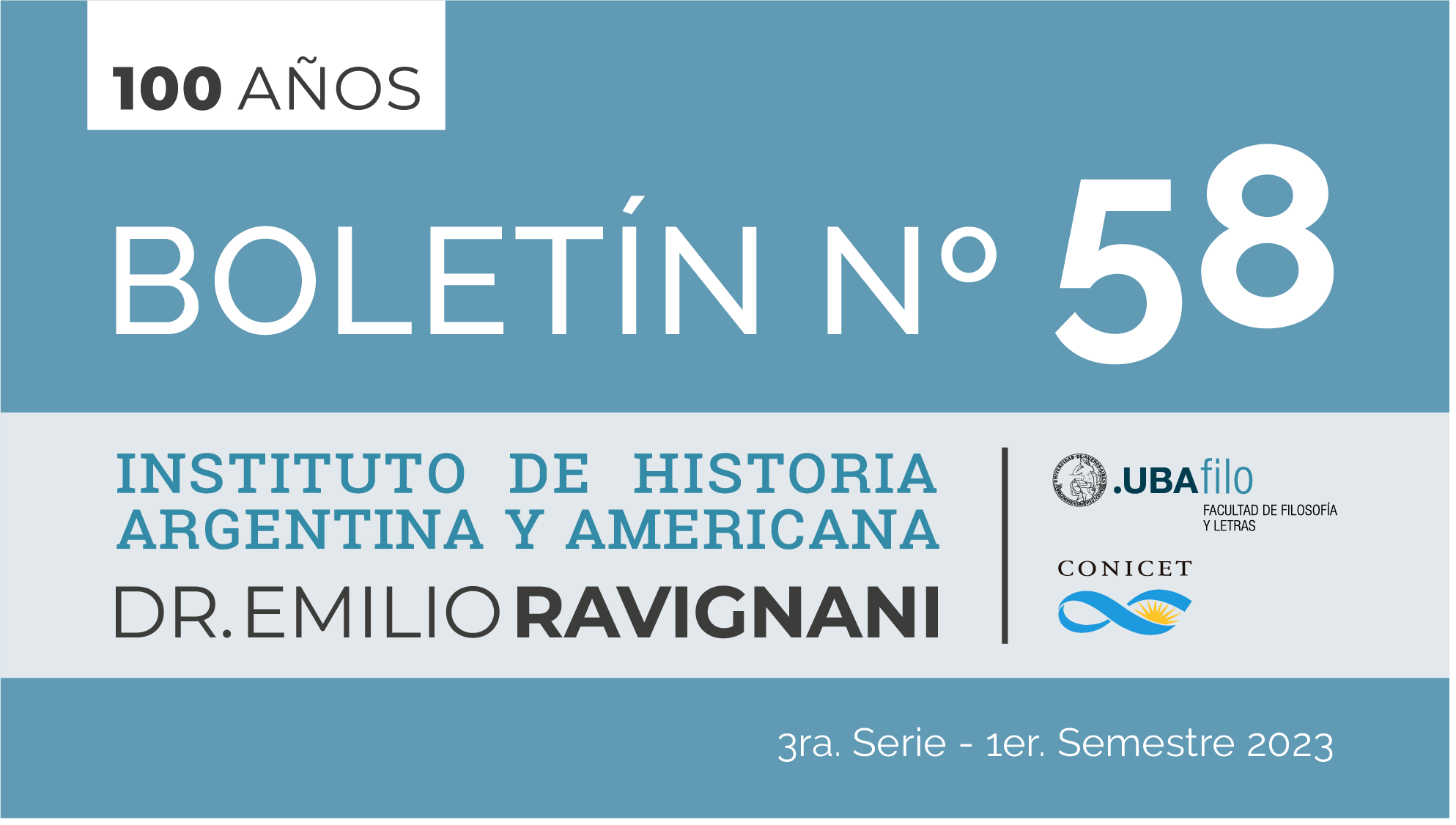The Beverly Hillbillies – fortunate peasants: Wealth in Argentina
Abstract
This paper revisits the lines of analysis that have differentiated the high income of the export boom in Argentina and its development –defined as the combination of human capital, technical knowledge, physical capital and institutions–. It underlines the stages of growth and stagnation, and social and regional differences. It discusses the effect of growth on development, in relation to other countries that have enjoyed stronger development than our case. Following Schiaffino, it considers the role of regional inequalities and the limited growth of human capital in this process.Downloads
References
Aráoz, M. F. (2013). La calidad institucional en Argentina en el largo plazo. Revista de Historia Económica, 31(1).
Badía-Miró, M., Carreras-Marín, A. y Rayes, A. (2016). La diversificación del comercio de exportación latinoamericano, 1870-1913. Los casos de Argentina, Chile y Per. En C. Zuleta y M. A. Lopes (Eds.), Mercados en común. Estudios sobre conexiones, negocios y diplomacia en las Américas (siglos XIX y XX) (pp. 45-77). México: El Colegio de México.
Barsky, O. y Gelman, J. (2001). Historia del agro argentino. Buenos Aires: Sudamericana.
Bragoni, B., Míguez, E. y Paz, G. (en prensa). Las dirigencias políticas argentinas de la organización nacional. Buenos Aires: Edhasa.
Cortés Conde, R. y Hunt, S. (2005). Latin American Economies, Growth and the Export Sector, 1880-1930. New York: Holmes and Meyer.
Di Tella, R., Glaeser, E. L. y Llach, L. (2013). Exceptional Argentina. Los trabajos de esta compilación han sido publicados en diferentes medios; a efectos de economizar especio, cito aquí esta versión, disponible en http://piketty.pse.ens.fr/files/DiTellaetal2013.pdf .
Djenderedjian, J. y Santilli, D. (2017). The shift to 'modern' and its consequences: Changes in property rights and land wealth inequality in Buenos Aires, 1839-1914. En R. Congost, J. Gelman y R. Santos (Eds.), Property Rights in Land. Issues in social, economic and global history (pp. 74-90). Oxon-New York: Routledge.
Elis, R. (2011). Redistribution under Oligarchy: Trade, Regional Inequality and the Origins of Public Schooling in Argentina, 1862-1912. Tesis de doctorado sin publicar, Department of Political Science, Stanford University.
Frankema, E. (2010). Reconstructing labor income shares in Argentina, Brazil and Mexico, 1870-2000. Revista de Historia Económica, 28(2).
Geller, L. (s/f). El modelo de poder de la generación del 80. Política cambiaria Argentina: 1890 y 1914. Buenos Aires: Centro de investigaciones en Ciencias Sociales (CICSO), mimeo.
Gelman, J. (Coord.) (2011). El mapa de la desigualdad en la argentina del siglo XIX. Rosario: Prohistoria.
Gelman, J. y Santilli, D. (2018). Wages and standards of living in the 19th Century from a comparative perspective. Consumption basket, Bare Bone Basket and welfare ratio in Buenos Aires, 1825-1849. Investigaciones en Historia Económica.
Gerchunoff, P. y Hora, R. (2021). La moneda en el aire. Buenos Aires: Siglo XXI.
Gerchunoff, P. (2016). El eslabón perdido. La economía política de los gobiernos radicales (1916-1930). Buenos Aires: Edhasa.
Gerchunoff, P. y Llach, L. (2004). Entre la equidad y el crecimiento. Buenos Aires: Siglo XXI.
Gerchunoff, P. y Llach, L. (2009). Equality Or Growth: A 20th Century Argentine Dilemma. Revista de Historia Económica, Journal of Iberian and Latin American Economic History, XXVII, 3.
Gerchunoff, P. y Llach, L. (2018) El ciclo de la ilusión y el desencanto. Políticas económicas argentinas de 1880 a nuestros días. Buenos Aires: Crítica.
Gerchunoff, P., Rocchi, F. y Rossi, G. (2008). Desorden y progreso. Buenos Aires: Edhasa.
Gerchunoff, P. y Torre, I. (2013). ¿Estaba la población argentina en el lugar equivocado? Un enfoque de economía política sobre las migraciones (1880-1914). Desarrollo Económico, 54(212).
Hora, R. (2000). Terratenientes, empresarios industriales y crecimiento industrial en la Argentina: los estancieros y el debate sobre el proteccionismo (1890-1914). Desarrollo Económico, 40.
Hora, R. (2001). Terratenientes, industriales y clase dominante en la Argentina agroexportadora: respuesta a una crítica. Desarrollo Económico, 41.
Hora, R. (2018) ¿Cómo pensaron los argentinos el campo? Y como lo piensan hoy cuando ese campo ya no existe. Buenos Aires: Siglo XXI.
Kuntz-Ficker, S. y Rayes, A. (2019). La contribución de las exportaciones a la economía argentina, 1875-1929. En S. Kuntz-Ficker, La Primera Era Exportadora reconsiderada. Una revaloración de su contribución a las economías latinoamericanas. México D.F.: El Colegio de México.
Ladeuix, J. y Schiaffino, P. (2020a). El gigante con pies de barro: ¿Fue la Argentina realmente rica? El capital humano durante la primera globalización en una perspectiva comparada. Revista de Historia Económica, pp. 1-35.
Ladeuix, J. y Schiaffino, P. (2020b) Riche comme un argentin: desigualdad educativa en la Argentina de la belle époque. Investigaciones en historia económica, 16(3).
Maddison Project 2020:
https://www.rug.nl/ggdc/historicaldevelopment/maddison/releases/maddison-project-database-2020?lang=en
Míguez, E. J. (2005). El fracaso argentino. Interpretando la evolución económica en el corto siglo XX. Desarrollo Económico, 44(176).
Míguez, E. J. (2017). Del feudalismo al capitalismo agrario: ¿el fin de la historia... agraria? Boletín del Instituto de Historia Argentino Americana “Dr. Emilio Ravignani”, 46.
Páez de la Torre, C. (2001). Nicolás Avellaneda, una biografía. Buenos Aires: Planeta.
Pinilla, V. y Rayes, A. (2019). How Argentina became a super exporter of food and agricultural products during the First Globalization. Cliometrica, 13(3), pp. 443-469.
Prados de la Escosura, L. y Sanz Villaroya, I. (2006). Contract Enforcement and Argentina’s Long-Run Decline, en https://www.researchgate.net/publication/4724494_Contract_Enforcement_and_Argentina's_Long-Run_Decline
Rocchi, F. (1998). El imperio del pragmatismo: intereses, ideas e imágenes en la política industrial del orden conservador. Anuario IEHS, 13.
Santilli, D. (2019). La desigualdad en la Argentina. Apuntes para su historia, de la colonia a nuestros días. Rosario: Prohistoria.
Sokoloff, K. L. y Engerman, S. L. (2000). Institutions, Factor Endowments, and Paths of Development in the New World. Journal of Economic perspectives, 14(3).
Tedesco, J. C. (1982). Educación y sociedad en la Argentina. Buenos Aires: Centro Editor de América Latina.
Williamson, J. (1995). The evolution of global labour markets since 1930: Background evidence and hypothesis. Explorations in Economic History, 32.
Williamson, J. (1999). Real Wages, Inequality, and Globalization in Latin America Before 1940. Revista de Historia Económica, 17.
Copyright (c) 2022 Boletín del Instituto de Historia Argentina y Americana Dr. Emilio Ravignani

This work is licensed under a Creative Commons Attribution-NonCommercial 4.0 International License.
The copyright is transferred to the Boletín, but the authors may retrieve them and reproduce their work in other media or formats by means of a written request to the Editorial Committee. In such cases, the Boletín will be cited as the first publication of the work.
The works are licensed under a Creative Commons Attribution-NonCommercial 4.0 International License, which allows others to share the work with an acknowledgment of their authorship and initial publication in this journal.
Also, by written request to the Editorial Committee of the Boletín, the authors may separately establish additional agreements for the non-exclusive distribution of the version of the work published in this journal (for example, placing it in an institutional repository or publishing it in a book), with an acknowledgement of its initial publication here. No commercial uses are allowed.



















